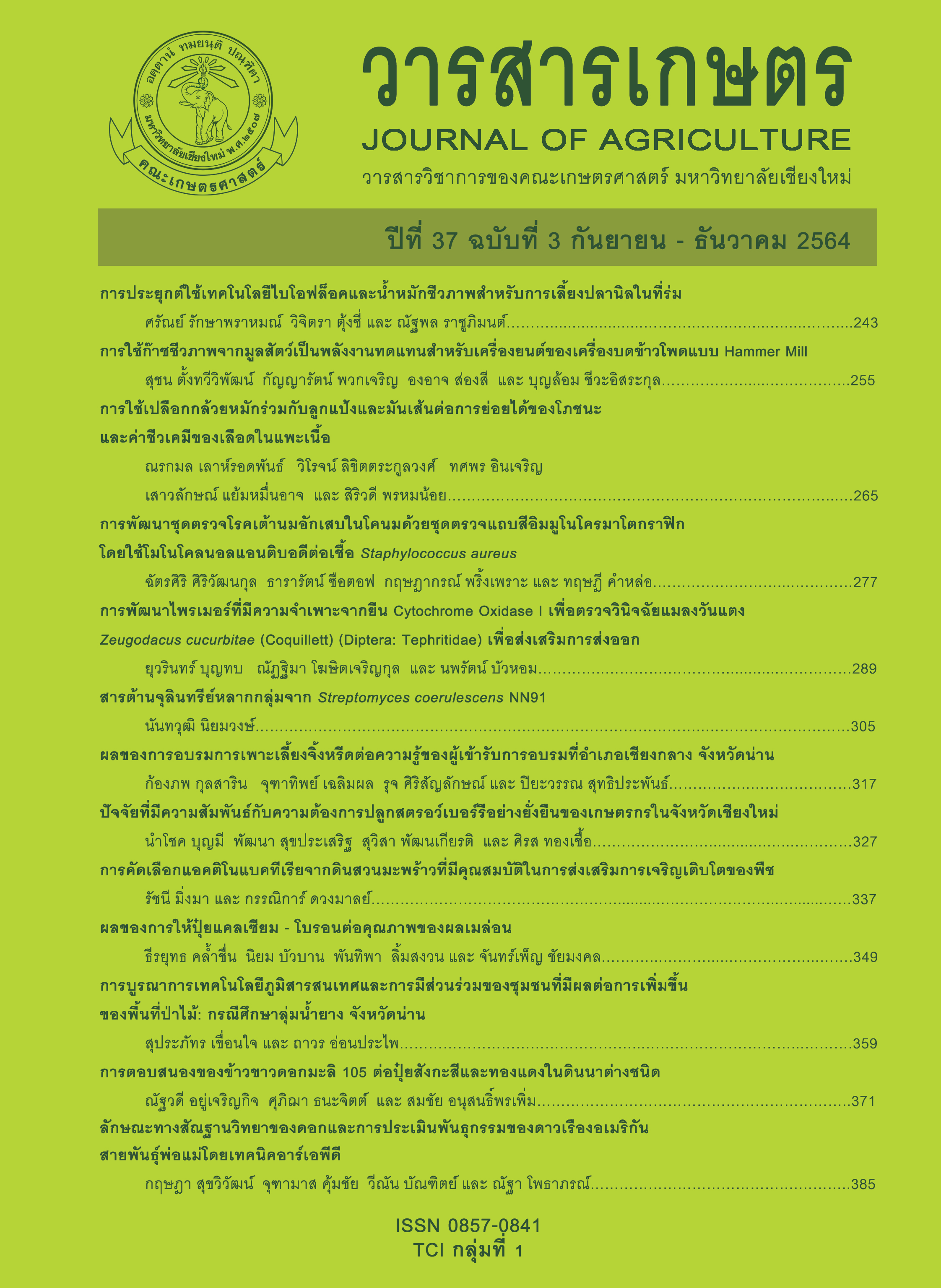การตอบสนองของข้าวขาวดอกมะลิ 105 ต่อปุ๋ยสังกะสีและทองแดงในดินนาต่างชนิด
Main Article Content
บทคัดย่อ
คัดเลือกดินนาตัวแทนในพื้นที่ทุ่งกุลาร้องไห้ ประกอบด้วย ชุดดินท่าตูม ชุดดินร้อยเอ็ด และชุดดินอุบลมาปลูกข้าวขาวดอกมะลิ 105 ในโรงเรือนเพื่อศึกษาการตอบสนองต่อสังกะสีหรือทองแดงในอัตราที่แตกต่างกัน ได้แก่ 0, 0.5, 1, 2 และ 4 มิลลิกรัมสังกะสีต่อกิโลกรัม หรือ 0, 0.3, 0.6, 1.2 และ 2.4 มิลลิกรัมทองแดงต่อกิโลกรัม พบว่า การใส่สังกะสีหรือทองแดงต่างไม่มีผลต่อน้ำหนักตอซังแห้งและน้ำหนักเมล็ด แต่สังกะสีจะเร่งการออกรวงและเพิ่มความสูงของข้าวอย่างมีนัยสำคัญทางสถิติโดยการใส่สังกะสีในทุกอัตราให้ความสูงของข้าวในชุดดินอุบลเพิ่มขึ้นและมีค่าสูงสุดเมื่อใส่อัตรา 1 มิลลิกรัมต่อกิโลกรัม ขณะที่การใส่ในอัตรา 2 และ 4 มิลลิกรัมต่อกิโลกรัม ให้ความสูงข้าวในชุดดินร้อยเอ็ดสูงสุดไม่ต่างกัน (162 - 165 เซนติเมตร) และข้าวที่ปลูกในดินทั้งสองจะออกรวงเร็วที่สุดเพียง 79.3 และ 83.7 วันหลังปักดำเมื่อใส่สังกะสีในอัตรา 4 มิลลิกรัมต่อกิโลกรัม ส่วนทองแดงทำให้ความสูงของข้าวลดลงยกเว้นในชุดดินท่าตูมที่การใส่ทองแดงในทุกอัตราให้ความสูง (162 - 167 เซนติเมตร) และจำนวนเมล็ดดี (ร้อยละ 76.3 - 80.0) ของข้าวเพิ่มขึ้นไม่แตกต่างกันยกเว้นในอัตรา 1.2 มิลลิกรัมต่อกิโลกรัม นอกจากนี้ การใส่ทองแดงอัตรา 2.4 มิลลิกรัมต่อกิโลกรัม ให้จำนวนเมล็ดดีในชุดดินอุบลสูงสุด (ร้อยละ 81.7) และเพิ่มจำนวนรวงข้าวในชุดดินร้อยเอ็ดได้สูงสุดไม่แตกต่างจากการใส่ในอัตรา 0.3 มิลลิกรัมต่อกิโลกรัม (11.3 - 12.3 รวงต่อกระถาง)
Article Details
References
Alloway, B.J. 2008. Zinc in Soils and Crop Nutrition. 2nd ed. International Zinc Association, Brussels.
Cakmak, I. 2008. Enrichment of cereal grains with zinc: Agronomic or genetic biofortification? Plant and Soil 302 (1): 1-17.
Cox, F.R. and J.I. Wear. 1977. Diagnosis and Correction of Zinc Problems in Corn and Rice Production. Southern Cooperative Series Bulletin 222 Raleigh, North Carolina State University, Raleigh.
Dobermann, A. and T. Fairhurst. 2000. Rice: Nutrient Disorders and Nutrient Management. Oxford Graphic Printers, Singapore.
Fageria, N.K. 2014. Mineral Nutrition of Rice. CRC Press, Boca Ration.
FAO/WHO. 2000. Preliminary report on recommended nutrient intakes. Report of a Joint FAO/WHO Expert Consultation on Human Vitamin and Mineral Requirements. Bangkok, Thailand.
Haefele, S.M., K. Naklang, D. Harnpichitvitaya, S. Jearakongman, E. Skulkhu, P. Romyen, S. Phasopa, S. Tabtim, D. Suriya-arunroj, S. Khunthasuvon, D. Kraisorakul, P. Youngsuk, S.T. Amarante and L.J. Wade. 2006. Factors affecting rice yield and fertilizer response in rainfed lowlands of northeast Thailand. Field Crops Research 98(1): 39-51.
Hafeez, B., Y.M. Khanif and M. Saleem. 2013. Role of zinc in plant nutrition- a review. American Journal of Experimental Agriculture 3(2): 374-391.
Kabata-Pendias, A. and H. Pendias. 2001. Trace Elements in Soils and Plants, 3rd ed. CRC Press, Boca Ration.
Kunlanit, B., C. Wangpoomyai, M. Vongsavas, T. Siritrakulsak, K. Maneepradid and P. Vityakon. 2019. Effects of zinc and silicon on growth and yield of rice cv. Khao Dawk Mali 105. Khon Kaen Agriculture Journal 47(4): 839-850. (in Thai)
Mortvedt, J.J., P.M. Giordano. and W.L. Lindsay. 1972. Micronutrients in Agriculture. Soil Science Society of America, Madison, Wisconsin.
Muthukumararaja, T.M. and M.V. Sriramachandrasekharan. 2012. Effect of zinc on yield, zinc nutrition and zinc use efficiency of lowland rice. Journal of Agricultural Technology 8(2): 551-561.
Norasing, U., S. Thanachit, S. Anusonpornperm and I. Kheoruenromne. 2017. Variability and potential of jasmine rice growing soils in northeast Thailand. Khon Kaen Agriculture Journal 45(1): 121-132. (in Thai)
Pandey, N., G.C. Pathak and C.P. Sharma. 2006. Zinc is critically required for pollen function and fertilization in lentil. Journal of Trace Elements in Medicine and Biology 20(2): 89-96.
Saleque, M.A., M.J. Abedin, Z.U. Ahmed, M. Hasan and G.M. Panaullah. 2001. Influences of phosphorus deficiency on the uptake of nitrogen, potassium, calcium, magnesium, sulfur, and zinc in lowland rice varieties. Journal of Plant Nutrition 24(10): 1621-1632.
Siddika, M.A., M.J.A. Mian, T.S. Hoque, M.A. Hanif and P.C. Ray. 2016. Effect of different micronutrients on growth and yield of rice. International Journal of Plant and Soil Science 12(6): 1-8.
Slation, N.A., E.E. Gbur, C.E. Wilson and R.J. Norman. 2005. Rice response to granular zinc sources varying in water-soluble zinc. Soil Science Society of America Journal 69(2): 443-452.
Sukyankij, S., S. Thanachit, S. Anusontpornperm and I. Kheoruenromne. 2020. Assessment of soil Zn availability for Khao Dawk Mali 105 rice: a case study in Thailand. Journal of Crop Science and Biotechnology 23(2): 181–190.
Takkar, P.N. and N.S. Randhawa. 1978. Micronutrients in Indian agriculture. Fertilizer News. 23(8): 3-26.
Verma, T.S. and R.S. Minhas. 1987. Zinc and phosphorus interaction in wheat-maize cropping system. Fertilizer Research 13(1): 77-86.
Yoshida, S., D.A. Forno, J.H. Cock and K.A. Gomez. 1976. Laboratory Manual for Physiological Studies of Rice. 3rd ed. IRRI, Los Baños, Laguna.
Yoshihashi, T., N. Kabaki, T.T.H. Nguyen and H. Inatomi. 2002. Formation of flavor compound in aromatic rice and its fluctuations with drought stress. JIRCAS Research Highlights 2002: 32-33.
Zayed, B.A., A.K.M. Salem and H.M.E. Sharkawy. 2011. Effect of different micronutrient treatments on rice (Oryza sativa L.) growth and yield under saline soil conditions. World Journal of Agricultural Research 7(2): 179-184.

